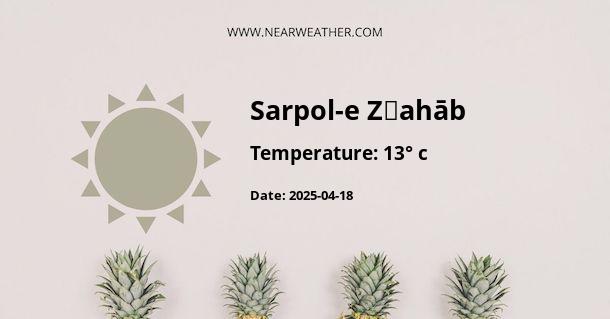Introduction
Sarpol-e Zahab is a city located in the Western part of Iran, specifically in the Kermanshah Province. This region is known for its continental climate, characterized by hot summers and cold winters. The city's geography, including its relative elevation and inland location, plays a significant role in its climate patterns throughout the year. This article provides a comprehensive overview of Sarpol-e Zahab's climate, including its temperature, precipitation, and other weather conditions.
Climate Overview
Sarpol-e Zahab experiences a typical semi-arid climate, according to the Köppen-Geiger climate classification. This type of climate, represented as BSk, is characterized by low annual rainfall and significant temperature variations between seasons. The city experiences hot, dry summers with average temperatures ranging between 30-40°C, and cold winters with temperatures often falling below freezing.
"The climate in Sarpol-e Zahab is hot in summer and cold in winter with a significant temperature range, indicative of a typical semi-arid climate."
Temperature
The average annual temperature in Sarpol-e Zahab is about 16.6°C. The warmest month is July, with an average temperature of around 30°C, while the coldest month is January, with an average temperature of about 2°C.
Summer
The summer months in Sarpol-e Zahab, spanning from June to September, are characterized by high temperatures, often exceeding 30°C, especially in July and August. The heat can be intense during the day, but the nights are generally cooler, providing some relief.
Winter
Winter in Sarpol-e Zahab extends from December to February. The city experiences cold weather during these months, with temperatures often falling to below freezing. Snowfall can occur, but it is generally light and infrequent.
Precipitation
Sarpol-e Zahab receives an average annual rainfall of about 382 mm. The majority of the rainfall occurs in the winter months, with December being the wettest month. The summer is generally dry, with little to no rainfall.
Winter Rainfall
During the winter, Sarpol-e Zahab receives the majority of its annual rainfall. December is typically the wettest month, with an average precipitation of about 70 mm. This precipitation mainly falls as rain, but occasional snowfall can also occur.
Summer Rainfall
The summer months are much drier, with virtually no rainfall from June through September. This period of drought contributes to the hot and dry conditions typical of the city's summer climate.
Humidity and Wind
Humidity levels in Sarpol-e Zahab vary throughout the year, with higher humidity during the winter months and lower humidity in the summer. The city also experiences regular winds, which can intensify the cold in winter and the heat in summer.
Conclusion
In conclusion, Sarpol-e Zahab, with its semi-arid climate, experiences significant seasonal variations in temperature and precipitation. The city's hot, dry summers and cold winters are characteristic of its continental climate. An understanding of these climate patterns is essential for planning travel or living in this region of Iran. Whether you are a visitor keen to explore the cultural heritage of the region or a resident adapting to the local weather patterns, being aware of the climatic conditions can ensure a more comfortable and enjoyable experience.
A - Sarpol-e Z̄ahāb's Latitude is 34.461090 & Longitude is 45.862640.
A - Weather in Sarpol-e Z̄ahāb is 13° today.
A - Climate Conditions in Sarpol-e Z̄ahāb shows clear sky today.
A - Humidity in Sarpol-e Z̄ahāb is 38% today.
A - Wind speed in Sarpol-e Z̄ahāb is 17.14 km/h, flowing at 99° wind direction. today.
